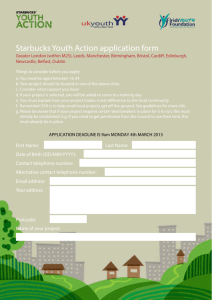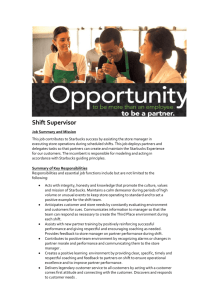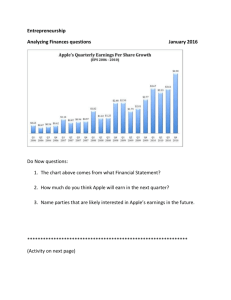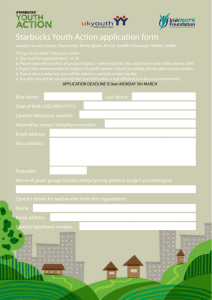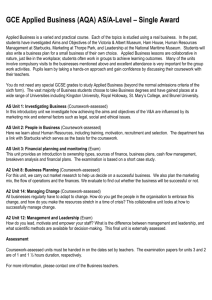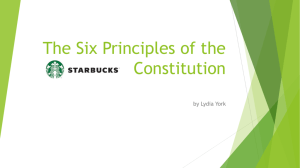jigbak_m6_a2-final
advertisement
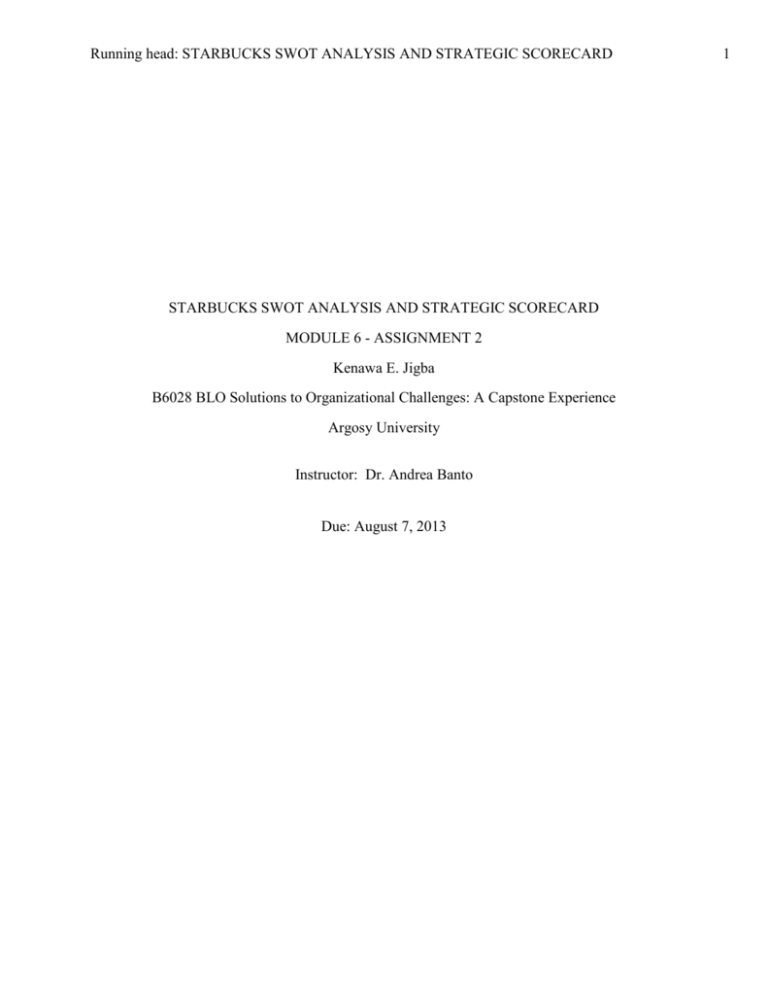
Running head: STARBUCKS SWOT ANALYSIS AND STRATEGIC SCORECARD STARBUCKS SWOT ANALYSIS AND STRATEGIC SCORECARD MODULE 6 - ASSIGNMENT 2 Kenawa E. Jigba B6028 BLO Solutions to Organizational Challenges: A Capstone Experience Argosy University Instructor: Dr. Andrea Banto Due: August 7, 2013 1 STARBUCKS SWOT ANALYSIS AND STRATEGIC SCORECARD Starbucks SWOT Analysis and Strategic Scorecard SWOT ANALYSIS STRENGTHS The organizations vision is to be a WEAKNESSES catalyst of change. Brand recognition and customer loyalty Diverse product portfolio catering to all term growth prospects No monetary switching costs for customers tastes and ages, including non-coffee Negative large corporation image beverages and food items Pay 23% more for coffee than market prices Excellent customer service and the value of the Starbucks experience Saturation of the market diminishes long- Potential limitations of international Licensing relationship with top-brands expansion due to cultural clashes with such as Pepsi-Cola and Kraft that American coffee experiences minimize costs and leverage the strategic advantages of those companies Strong employee relationships Economies of scale providing superior distribution networks and supplier power Primly-located retail stores Positive image attributed to social responsibility STARBUCKS SWOT ANALYSIS AND STRATEGIC SCORECARD OPPORTUNITIES Appealing to students and creating External forces such as unstable inviting drink sensations that would governments especially in some parts of motivate a special visit and acceptance Africa have posed considerable threat to of a higher price. the growth and expansion of the company There is great support politically for the (Kurtz, 2009). company to venture in new markets. In THREATS There have been other challenges such as all the countries that the company is poor understanding; lack of interest and targeting, there has been good will and attitudinal issues especially from the local support from such countries. communities among the target groups has Have the ability to reduce premiums posed threats to the expansion of the paid for coffee company (Tasker, 1997). Room for international expansion (75% In some parts especially in the new of revenues came from the United markets, there has been a challenge in States in fiscal 2007 and international accessing the targeted groups due to poor same-store sales growth is strong) infrastructure. Room to compete on multiple fronts Increasing coffee and diary prices including quality and price Intense competition in the specialty coffee STARBUCKS SWOT ANALYSIS AND STRATEGIC SCORECARD further utilize brand strength to capture beverage business Increase licensing relationships to profits at little cost to the company lower the demand for expensive There has also been great support from beverages the traditional investors as well as the Community resistance to store expansion new ones. All the stakeholders have The possibility that the demand for shown great support for the company so far. Support from the media has made the company to make a great leap. Unfavorable economic conditions that specialty coffee is a fad Further diversification of fast food restaurants that cuts into market share Communities in the new markets have received the company very well and have supported the company greatly. Starbucks SWOT Analysis and Strategic Scorecard The proposed scorecard strategic objectives are shown attached (last page; Appendix 1) and are based on my SWOT analysis. Kaplan & Norton Balanced Scorecard show that the perspectives would interact with each other, with learning and growth improving both internal business process and customer satisfaction for example. Then, in turn, the improved business process and customer satisfaction would impact and improve the financial perspective. These relationships are shown below as Exhibit 1.1 (Buggey, 2007). STARBUCKS SWOT ANALYSIS AND STRATEGIC SCORECARD Two strengths and opportunities discussed in my SWOT analysis are appealing to students and creating inviting drink sensations that would motivate a special visit and acceptance of a higher price. I have proposed two objectives. First, that Starbucks aggressively create new distinctive recipes, such as the Chip Coffee, that establish Starbucks as the drink innovator in the industry. Currently other brands create “knock offs” of Starbucks drinks. I propose that Starbucks continue to create drinks that create “knock off” envy. The initiative is to create an email and tweet campaign among Starbucks card users (most loyal customers) to suggest new flavor sensations. Give awards for most creative, most non-coffee like and so forth. The measure would be number of introductions with the goal being at least two major innovations a year. The second strategic objective in learning and growth would be to offer “study friendly” drinks for the student population. This would entail offering free “extra shots” with an exam STARBUCKS SWOT ANALYSIS AND STRATEGIC SCORECARD schedule and more advertising the week before midterms and finals on campus. The measure will be to share with the student drink market and the goal is 20% or more. For the internal business process, I recommend three strategic initiatives. First, I believe Starbucks needs to stick to its “perfect” drink commitment to maintain its quality image and price point. This requires backing up the promise with rework and redemption coupons. Secondly, I believe that Starbucks must compete during the rush hour by offering a better drink but not at the expense of getting to work on time. During rush hour, the most experience baristas will serve at the window and being the shift is fully stocked. Finally, the third strategic objective will be to offer more access to Starbucks items at non-Starbucks locations. This will be achieved through partnerships with local event venues with the goal of having an event monthly and one event for every 30,000 of the population. The customer perspective has two strategic initiatives in addition to add to the benefits that will accumulate from the strategic moves suggested in the learning and growth and internal business process perspectives. First, Starbucks will position themselves as the “affordable treat” in the downturn. What I am simply implying in this concept is that if you can afford a brown new car or go on vacation, or even get away, in this downturn economy, then it is eminent that you can also get away with Starbucks products for less than $5 and have a great time doing it. The second thing is that, Starbucks would start offering cell phone advertisements and tweet coupons to regular customers to try the new innovative drinks and get free coupons if any of their flavors are adopted. This would appeal to the technologically-advanced market segment. Finally, the financial perspective should enjoy the benefits of the strategic initiative and objectives in the other three perspectives. To make sure the benefits cascade into financial results, I propose two measures that are classics. First, return on sales. Even though we offer STARBUCKS SWOT ANALYSIS AND STRATEGIC SCORECARD targeted discounts, we have to maintain a certain margin to offer a reasonable return on equity to our owners. So, we have to maintain our average margins. We will do this by limiting discounts to those opportunities where we are creating new customers, or new “addictions” to high margin untried flavors. The goal is to create a new solid customer base that will continue and grow through the economic recovery. Secondly, the strategic objective is to create additional transactions without added “bricks and mortar” by offering Starbuck drinks at local venues. The measure is return on assets and should exceed cost of capital by a historical margin. Overall, the strategic objectives that are suggested create ideas that capitalize on strengths and support areas of weakness as noted in the SWOT analysis. Starbucks Balanced Scorecard The balanced scorecard requires that the organization be viewed from four main perspectives (Hefner, 2011). These perspectives include learning and growth, financial, internal business process and finally the customer perspective. The need to look at an organization from the four perspectives is to develop metrics, collection and interpretation of data relating it to all the four perspectives (Hefner, 2011). Learning and Growth Given this cause-and-effect relationship among the perspectives, I started with the learning and growth section. At this stage, there is need to focus at the employee training. Employees at Starbucks are trained with the objective that they are going to reach their full potential. Mediocrity and procrastination are avoided so that employees can realize what they are best at in a personal level and the potential the organization has (Hefner, 2011). The company therefore insists on timely and quality deliveries to its employees during the training period. The employees are made to understand that they do not need to package themselves to what they are STARBUCKS SWOT ANALYSIS AND STRATEGIC SCORECARD not but rather they are given room to develop themselves to be what they want to be (Kurtz, 2009). Learning goes on even after the basic orientation. Employees are made to understand that learning is a lifetime process and the only way for the company to be a step ahead of their competitors is through having a human resource that is knowledgeable. Information is therefore an important tool in the business. It is for this reason that the company has created a culture of information sharing. Employees are encouraged to share information to improve them and as a result improve the organization as a whole. Internal business It refers to the internal business processes. Managers interested in this perspective use metrics to measure the performance of their business, whether the company services and products do conform to the customer’s requirements. Managers at the Starbucks Corporation (SBUX) make sure that they develop metrics within the organization that are meant to measure these processes. Customer Starbucks Corporation has realized the need to value their customers from the very start. It is for this reason that one of the core values of the company is service excellence. Customer satisfaction is paramount since this induces repeats and referrals and hence more profits. To measure customer satisfaction, Starbucks Corporation (SBUX) is keen on several indicators. These indicators include customer repeats and referrals. If a customer is not satisfied, he or she will find another supplier who will meet their needs. It is therefore important to consider such indicators since their occurrence may mean decline in profits in future even when the current financial status looks just fine (Kurtz, 2009). STARBUCKS SWOT ANALYSIS AND STRATEGIC SCORECARD Managers at the SBUX Company have therefore designed metrics for customer satisfaction whereby the customers are analyzed. In this regard, customers are analyzed as individuals, the kind of processes through which the company is providing a service or a product to those particular customers. Financial Funding data is a major priority at the SBUX Company. The data has to be timely and accurate. The SBUX has implemented a corporate data base making sure that more of the data processing is centralized and automated. From past experiences, SBUX realized that more emphasis on financials led to the unbalanced situation with regard to all the other perspectives. It is for this reason that SBUX decided to include additional related financial data. Good examples would be the risk assessment not forgetting the cost benefit data. For Starbucks Corporation to succeed in achieving its objectives, it has come up with a strategy. The strategy is mapped in such a way that the company highlights the need to improve performance in the objectives that are found in the learning and growth perspective which forms the bottom row. Improved performance at this level has enabled the company to improve in its internal process objectives which form the second row up. Consequently, this has led the company to come up with desirable results to its customers and finance which forms the top row. Starbucks Corporation has not only focused on its goals as an organization but has also created a 360 degree in the way its employees think. This has ensured that people do not just think in a particular way but they instead explore on their way. This has been possible through the sharing of information and the freedom that the employees are given to utilize the knowledge acquired in practice without the fear of making mistakes. This way, the company can be said to STARBUCKS SWOT ANALYSIS AND STRATEGIC SCORECARD have made giant leaps over the last few decades while at the same time improving its employees at an equal rate. STARBUCKS SWOT ANALYSIS AND STRATEGIC SCORECARD References Buggey, T. (2007, Summer). A Picture Is Worth.... Journal of Positive Behavior Interventions, 9(3), 151-158. Retrieved December 14, 2007, from Academic Search Premier database. Buggey, T. (2007, Summer). Storyboard for Ivan's morning routine. Diagram. Journal of Positive Behavior Interventions, 9(3), 151. Retrieved August 6, 2013 from Academic Search Premier database Hefner, L. (2011). Network Balanced Scorecard . White Plains, NY: New York Kaplan, R. S., & Norton, D. P. (2007, Jul). Using the balanced scorecard as a strategic management system. Harvard Business Review, 85, 150-161. Retrieved from http://search.proquest.com/docview/227841808?accountid=34899 Kurtz, S. (2009). Balanced Scorecard Basics. New York: Cambridge University Press, New York Starbucks Corporation (SBUX) (2010). Form 10-K. United States Securities and Exchange Commission, Washington D. C. Starbucks Corporation, Seattle Washington. Financial Content.http://markets.financialcontent.com/stocks/quote/filings/quarterly?Symbol=SBU X. Retrieved 11-05-11. Sun, V. (2008). What is SWOT analysis. Englewood Cliffs, N. J.: Prentice Hall, Inc. Tasker, F. (1997). SWOT analysis . Englewood Cliffs, N. J.: Prentice Hall, Inc. STARBUCKS SWOT ANALYSIS AND STRATEGIC SCORECARD 12 Appendix 1 : Starbucks Balance Scorecard Objectives Measure Target Initiative Financial 1 Profitable transactions Return on sales will be 9% or higher Return on assets will exceed cost of capital by 5% or more Limit discounts to special flavors and high transaction customers. Percent increase in number of servings Number of coupons redeemed from tweets and cell phones 5% increase in sales volume 15% redemption rate Advertise the "affordable get-away": a Starbucks visit Offer discounts on particular new flavors using tweet coupons and cell phone coupons Number of re-made drinks or redemption tickets distributed Rework/redemption tickets are below 1% of drinks served Offer redemption ticket or rework for any drink that is not perfect. Return on sales 2 Leverage assets with nonstore profits Customer 1 Be the "affordable treat" in a down market 2 Appeal to the technology savvy, educator buyer Internal Business Process 1 Perfect drink every time 2 Quick drive through during rush mornings Create access to Starbuck 3 products at social, sporting and fun events Learning and Growth Create new taste sensations 1 -- be the drink innovator of the industry Return on assets Drive through orders completed in two minutes or less Number of non-store events offering Starbucks each month 95% of drink-only orders completed in two minutes One event for every 30,000 in the population per month Number of new drinks introduced each year Two major innovations a year (or more) Event sales will increase transactions without increasing assets employed Put experienced baristas on drivethrough during 6-9 am rush. Have all stations stocked prior to 6am. Create partnerships with event suppliers in area Solicit customers for ideas; offer rewards for flavor suggestions STARBUCKS SWOT ANALYSIS AND STRATEGIC SCORECARD 2 Offer trendy "study friendly" drinks for student Share of market of student population 20% or more of student market Advertise on campus the week before midterm and final exams. Offer free extra shots with final exam schedule. 13
